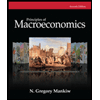
Foundations of Economics (8th Edition)
8th Edition
ISBN: 9780134486819
Author: Robin Bade, Michael Parkin
Publisher: PEARSON
expand_more
expand_more
format_list_bulleted
Question
Chapter 6, Problem 5MCQ
To determine
To select:
The option that correctly explains the situation that can happen when marginal benefit from a good exceeds its marginal cost.
Expert Solution & Answer
Want to see the full answer?
Check out a sample textbook solution
Students have asked these similar questions
Two firms are competing in a Cournot duopoly. Both firms have the same constant marginal cost. The market demand is linear.
Suppose the constant marginal cost of firm 2 is increasing.
Which of the following statements are correct? [There may be more than one correct statement.]
The quantity of firm 1 and the quantity of firm 2 both go up.
The quantity of firm 1 goes up and the quantity of firm 2 goes down.
The market price goes down.
The market price goes up.
The quantity of firm 1 and the quantity of firm 2 go down.
The quantity of firm 1 goes down and the quantity of firm 2 goes up.
The market price stays the same.
evaluate the impact of government interventions, such as antitrust regulations, price controls, or subsidies, on various market structures. Select a specific industry and examine how these interventions have influenced competition, consumer welfare, and economic efficiency. Provide the pros and cons of government intervention.
Consider an economy that exhibits both population growth (L grows at rate n) and
technological progress (A grows at rate a) described by the production function,
Y = F(K, AL) = Ka (AL)¹-α
Here K is capital and Y is output.
(a) Show that this production function exhibits constant returns to scale. [2 marks]
(b) What is the per-effective-worker production function, y = f(k), (where y = Y/AL
k K/AL)? (Show your working.)
[2 marks]
(c) Find expressions for the steady-state capital-output ratio, capital stock per
effective worker, and output per effective worker, as a function of the saving rate
(s), the depreciation rate (8), the population growth rate (n), the rate of
technological progress (a), and the coefficient a. (You may assume the condition
that capital per effective worker evolves according to Ak = sf (k) - (a+n+8)k.)
[5 marks]
(d) Show that at the Golden Rule steady state the saving rate for this economy is
equal to the parameter a.
[6 marks]
Chapter 6 Solutions
Foundations of Economics (8th Edition)
Ch. 6 - Prob. 1SPPACh. 6 - Prob. 2SPPACh. 6 - Prob. 3SPPACh. 6 - Prob. 4SPPACh. 6 - Prob. 5SPPACh. 6 - Prob. 6SPPACh. 6 - Prob. 7SPPACh. 6 - Prob. 8SPPACh. 6 - Prob. 9SPPACh. 6 - Prob. 10SPPA
Ch. 6 - Prob. 11SPPACh. 6 - Prob. 12SPPACh. 6 - Prob. 1IAPACh. 6 - Prob. 2IAPACh. 6 - Prob. 3IAPACh. 6 - Prob. 4IAPACh. 6 - Prob. 5IAPACh. 6 - Prob. 6IAPACh. 6 - Prob. 7IAPACh. 6 - Prob. 8IAPACh. 6 - Prob. 9IAPACh. 6 - Prob. 1MCQCh. 6 - Prob. 2MCQCh. 6 - Prob. 3MCQCh. 6 - Prob. 4MCQCh. 6 - Prob. 5MCQCh. 6 - Prob. 6MCQCh. 6 - Prob. 7MCQ
Knowledge Booster
Similar questions
- A firm faces the following production function, Y = AKα L¹-a (1) Here Y is output, K is capital, L is fixed labour, and A is a measure of technology. The firm uses an optimal amount of capital determined by the condition, MPK = r +8 (2) Where MPK is the marginal productivity of capital, r is the real interest rate, and ♪ is the depreciation rate. (a) Using equations (1) and (2) find an expression for K*, the optimal amount of capital the firm should use. [3 marks] (b) Referring to your result from part (a), comment on what happens to K* when each of the following variables change (holding other variables constant), (i) The measure of technology (A) falls (ii) The depreciation rate (8) increases (iii) The real interest rate (r) increases [2 marks] [2 marks] [2 marks] [Hint: For each of parts (i)-(iii) you are being asked to comment on what happens to K* if just the variable mentioned in the question part changes. Your answer should state whether K* increases, decreases, or stays the…arrow_forwardIn the week-4 materials, when deriving labour supply, we assumed that the substitution effect dominated the income effect. What impact would there be on labour supply if this was not the case? Briefly investigate how such a change could theoretically affect the imposition of a minimum wage above the market clearing wage. (Your answer is likely to benefit from diagrammatic support.)arrow_forwardRefer to the attached Wk 3 Graph for this assignment. The graph shows an increase in demand (shifting of the demand curve from D1 to D2). Choose an application or situation in the economy or a specific economic situation to describe this graph. Take into consideration the impact on quantity and price in your analysis. Given your analysis, what would cause the situation to go the opposite way? What would cause the situation to go further into the same direction?arrow_forward
- Click on the link to study the Economics in the News. Then answer the following questions. 120- 118- 3. Use the AS-AD model to show the changes in aggregate demand and aggregate supply that occurred in 2016 and 2017 that brought the economy to its situation in mid-2017. The graph shows the U.S. economy in the second quarter of 2016. Draw and label the long-run aggregate supply curve in 2017. Draw and label the aggregate demand curve in 2017. Draw a point at the short-run macroeconomic equilibrium in the second quarter of 2017. 116- 114- ☑--- Price level (GDP deflator, 2009=100) LAS 16 112- 110- 108- 106- 104- 102- $16.7 100- 16.6 16.7 16.8 16.9 17.0 SAS 16 = SAS17 AD 16 17.1 17.2 17.3 Real GDP (trillions of 2009 dollars) >>> Draw only the objects specified in the question. LV ☑arrow_forwardPrice level (GDP deflator, 2009=100) Fed Raises Rates As Job Gains, Firming Inflation Stoke Confidence The U.S. Federal Reserve raised interest rates on Wednesday. The rate rise was the second in three months. This second rise comes in an economy that is growing faster and creating jobs at a more rapid pace. These gains are accompanied by a rising inflation rate. 140- 130- Source: Reuters, March 15, 2017 Describe the process by which the Fed's action reported in the news clip flows through the economy. 120- ... 110- LAS SAS → ☑ When the Fed raises the interest rate, A. aggregate demand decreases and short-run aggregate supply increases, and the price level falls B. aggregate demand increases and real GDP increases C. aggregate demand decreases and the price level falls D. short-run aggregate supply increases and the price level falls The graph shows the long-run aggregate supply curve and the short-run aggregate supply curve. Draw the AD curve to illustrate the state of the economy…arrow_forwardPrice level (GDP deflator, 2009=100) Millennials Are Starting to Spend More Millennials, who spend an average of $85 a day, are expected to spend at a higher rate in the next fifteen years. Only 37 percent of Americans report higher spending today than a year ago, while 42 percent of millennials say they are spending more. Millennials are spending more on rent or mortgages and leisure activities than they were spending a year ago. 140- 130- Source: Business Journal, May 25, 2016 120- Describe the macroeconomic equilibrium after the change in spending by millennials. If the economy had been at a below full-employment equilibrium, then the economy will A. move to an above full-employment equilibrium with real GDP less than potential GDP B. move to a full-employment equilibrium as short-run aggregate supply increases at the same time 'C. move to a full-employment equilibrium and equilibrium real GDP equals potential GDP D. remain stuck in a below full-employment equilibrium If the economy…arrow_forward
- Wolfgang is a typical producer in a perfectly competitive piano industry (i.e., all other producers of pianos face the same costs as Wolfgang). The following production and cost data apply to the long run as well as the short run. Fixed costs (rent) are unrecoverable in the short run and are equal to $2400 per month. Variable costs consist of raw materials (wire, wood, plastic), which cost $1000 per piano, and the $40 per hour opportunity cost of Wolfgang's time. Wolfgang's production function is given in the table at right. Wolfgang will shut down if the price per piano is less than OA. $3000. B. $4000. O C. $5000. ○ D. None of the above. Pianos (Q) Hours (L) Raw Materials ( 0 0 0 1 100 1000 2 150 2000 3 240 3000 4 400 4000arrow_forwardP2 P₁ $ per unit Using the graph below, determine which statement is TRUE. MC1 SRATC₁ Q1 Q₂ MC2 SRATC2 LRAC ✓ LEA Quantityarrow_forwardUsing the grapns below, wnicn snow the snort-run cost curves for 3 perfectly competitive firms in the same industry, determine whether the industry is in long-run equilibrium or not. Q Q Firm A QA MC ATC Output Firm B QB MC ATC Firm C MC ATC Output Output Qc If Firms A, B and C are in the same industry, is this industry in long-run equilibrium? ○ A. Yes, because P = MC = MR for each of the 3 firms. ○ B. No, because Firm A is not producing at a profit-maximizing level of output. ○ C. Yes, because all 3 firms are producing at their minimum average total cost. OD. The answer is uncertain since it's unknown whether the firms are producing at the minimum efficient scale or not. ○ E. No, because if the industry were in equilibrium, all 3 firms would be earning zero economic profits.arrow_forward
- Consider the table on the right, which shows the various revenue concepts for a perfectly competitive firm. Suppose the firm faces a constant market price of $4. Compute first total revenue for each level of output and fill in the TR column of the table. Next, compute marginal revenue for each level of output and fill in the MR column of the table. (Marginal revenue at each level of output is computed using total revenue for two successive levels of output. For example, marginal revenue at 160 uses total revenue for output levels 120 and 160.) Total Marginal Price (p)Quantity (Q) Revenue (TR)Revenue (MR) $4 A EA 120 $4 160 $4 200 $4 240 $4 280 $ EA EA EA 10 S คarrow_forwardThis week we will be discussing measures of economic well-being. Read the following short article from the Office of National Statistics from the U.K. which discusses different measures of economic well-being: https://blog.ons.gov.uk/2017/07/06/beyond-gdp-measuring-the-economic-well-being-of-individuals/ For this assignment, we will narrow down to the economic well-being of the St. Louis region (or another region you choose). As the article indicates there are different measures of well-being. You are interested in creating a Hypothesis Test about the economic well-being of the area. Discuss the following issues: First, think about your research hypothesis and justify it briefly. Remember, a hypothesis is a well-thought and untested proposition. What is the null hypothesis? What is the parameter you are interested in? (i.e., the measure of well-being). Is it going to be a Lower-Tail, Upper-Tail or Two-Tailed test? What is the data that you need and how will you collect the data? What…arrow_forwardJohnny brought $39.50 to the art supply store. He bought a brush, a sketchbook, and a paint set. The brush was 1 6 as much as the sketchbook, and the sketchbook cost 3 4 the cost of the paint set. Johnny had $2.00 left over after buying these items.arrow_forward
arrow_back_ios
SEE MORE QUESTIONS
arrow_forward_ios
Recommended textbooks for you
 Principles of MicroeconomicsEconomicsISBN:9781305156050Author:N. Gregory MankiwPublisher:Cengage Learning
Principles of MicroeconomicsEconomicsISBN:9781305156050Author:N. Gregory MankiwPublisher:Cengage Learning Essentials of Economics (MindTap Course List)EconomicsISBN:9781337091992Author:N. Gregory MankiwPublisher:Cengage Learning
Essentials of Economics (MindTap Course List)EconomicsISBN:9781337091992Author:N. Gregory MankiwPublisher:Cengage Learning Microeconomics: Private and Public Choice (MindTa...EconomicsISBN:9781305506893Author:James D. Gwartney, Richard L. Stroup, Russell S. Sobel, David A. MacphersonPublisher:Cengage Learning
Microeconomics: Private and Public Choice (MindTa...EconomicsISBN:9781305506893Author:James D. Gwartney, Richard L. Stroup, Russell S. Sobel, David A. MacphersonPublisher:Cengage Learning Economics: Private and Public Choice (MindTap Cou...EconomicsISBN:9781305506725Author:James D. Gwartney, Richard L. Stroup, Russell S. Sobel, David A. MacphersonPublisher:Cengage Learning
Economics: Private and Public Choice (MindTap Cou...EconomicsISBN:9781305506725Author:James D. Gwartney, Richard L. Stroup, Russell S. Sobel, David A. MacphersonPublisher:Cengage Learning Principles of Macroeconomics (MindTap Course List)EconomicsISBN:9781285165912Author:N. Gregory MankiwPublisher:Cengage Learning
Principles of Macroeconomics (MindTap Course List)EconomicsISBN:9781285165912Author:N. Gregory MankiwPublisher:Cengage Learning Principles of Microeconomics (MindTap Course List)EconomicsISBN:9781305971493Author:N. Gregory MankiwPublisher:Cengage Learning
Principles of Microeconomics (MindTap Course List)EconomicsISBN:9781305971493Author:N. Gregory MankiwPublisher:Cengage Learning

Principles of Microeconomics
Economics
ISBN:9781305156050
Author:N. Gregory Mankiw
Publisher:Cengage Learning

Essentials of Economics (MindTap Course List)
Economics
ISBN:9781337091992
Author:N. Gregory Mankiw
Publisher:Cengage Learning

Microeconomics: Private and Public Choice (MindTa...
Economics
ISBN:9781305506893
Author:James D. Gwartney, Richard L. Stroup, Russell S. Sobel, David A. Macpherson
Publisher:Cengage Learning

Economics: Private and Public Choice (MindTap Cou...
Economics
ISBN:9781305506725
Author:James D. Gwartney, Richard L. Stroup, Russell S. Sobel, David A. Macpherson
Publisher:Cengage Learning

Principles of Macroeconomics (MindTap Course List)
Economics
ISBN:9781285165912
Author:N. Gregory Mankiw
Publisher:Cengage Learning

Principles of Microeconomics (MindTap Course List)
Economics
ISBN:9781305971493
Author:N. Gregory Mankiw
Publisher:Cengage Learning